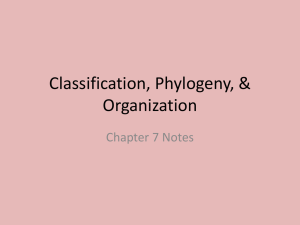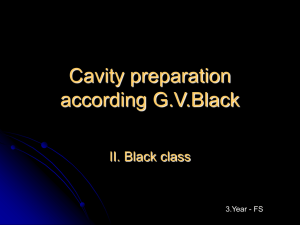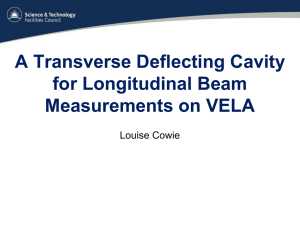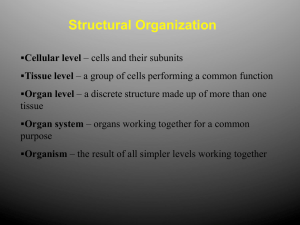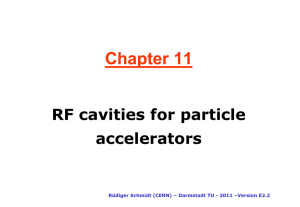Prezentacja programu PowerPoint
advertisement
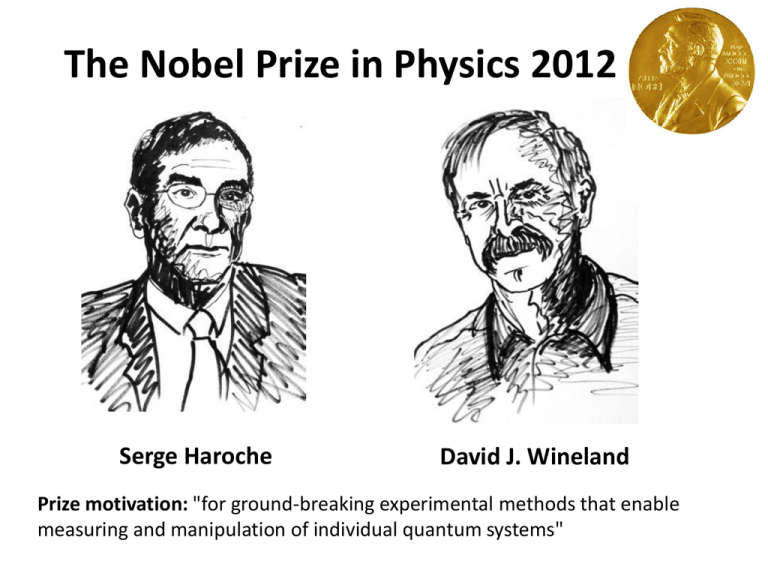
The Nobel Prize in Physics 2012 Serge Haroche David J. Wineland Prize motivation: "for ground-breaking experimental methods that enable measuring and manipulation of individual quantum systems" The Nobel Prize in Physics 2012 BCIT Magnetooptical atom trap used in atomic physics experiments The Nobel Prize in Physics 2012 Cavity Quantum Electrodynamics, SCIENTIFIC AMERICAN’1993 Experimental demonstration of cavity induced modification of spontaneous emissoin rate of Rydberg atoms BCIT The Nobel Prize in Physics 2012 Quantum non-demolition measurement Credit: Nobel Prize The Nobel Prize in Physics 2012 Quantum Dots in Photonic Structures Lecture 2: Basics of Quantum Cavity Electrodynamics Jan Suffczyński Wednesdays, 17.00, SDT Projekt Fizyka Plus nr POKL.04.01.02-00-034/11 współfinansowany przez Unię Europejską ze środków Europejskiego Funduszu Społecznego w ramach Programu Operacyjnego Kapitał Ludzki Plan for today 1. Cavity quality factor 2. Weak coupling regime 3. Strong coupling regime Reminder • Optical cavity: an arrangement of optical components which allows a beam of light to circulate in a closed path. • Optical cavity mode: EM field distribution which reproduce itself (if no losses) after one cavity round trip. A condtion: a phase shift after one round trip = an integer multiple of 2π. 𝜋∙𝑐 Mode frequencies: 𝜔𝑁 = N d 𝑑 • Quality factor: a measure of the rate at which optical energy decays from the cavity (absorption,scattering, leakage due to imperfect mirrors). Lifetime of the photon within the cavity: τ = 1/Γ= Q/ωc • Quantum fluctuations of the vacuum and the Casimir effect Q c / c Quality factor Q R R Blackboard calculation Quality factor Q Decay of the photon from a cavity due to absorption,scattering, leakage due to imperfect mirrors. Consider electric field at a given point inside a cavity: E 1 E t cos c t e E = Electric field magnitude u = Energy density 1 t 2 1/e 0 t 2/ Optical period T = 1/fc = 2/c u t 1 t e 2 2 e t Γ – optical energy decay time dut Energy density decay: e t dt 1. Definition of Q via energy storage: c StoredEnergy u t 1 2 Q 2 2 du t T T EnergyLostPerOptCycle dt 2. Definition of Q via resonance bandwidth: Fourier transform Time domain 1 E E t cos c t e Frequency domain 2 1 2 2 I E I 1 2 c t 2 1 t 2 1/e 2/ Lorentzian Q c c • The two definitions for Q are equivalent • This is how on can measure Q (not in the case of microcavities with QDs!) Quality factor vs. Finesse F - a measure of the rate at which optical energy decays from the cavity, but the optical cycle time T (in the case of Q) is replaced by round trip time tRT: Δ𝜔𝑐 = 𝜋∙𝑐 𝑑 c F c 1 StoredEnergy 2 EnergyLostPerRoundTrip Finesse: the ratio of free spectral range Δω (the frequency separation between successive longitudinal cavity modes) to the linewidth Γ of a cavity mode: F 𝚫𝝎𝒄 = 𝚪 „resolving power or spectral resolution of the cavity” Quality factor vs. Finesse Quality factor: number of optical cycles (times 2) before stored energy decays to 1/e of original value. Finesse: number of round trips (times 2) before stored energy decays to 1/e of original value. Q 𝝎𝒄 = 𝜞 F 𝜟𝝎𝒄 = 𝜞 When mirror losses dominate cavity losses: • F and Q similar in the case of micrometer size cavities (as Δω~ωc in that case) • Q can be increased by increasing cavity length • F is independent of cavity length ! Quality factor and typical values Number of bounces Decay time ps 8 6 4 2 0 0 5000 10 000 15 000 20 000 Quality factor 75 000 50 000 25 000 0 0 50 Quality factor 103 100 For Q = 5000 and λ = 700 nm, cavity length = λ/2 = 350 nm: • photon decay time τ = Q/ωc = 1.86 ps • Total run = τ *(speed of the light) = 557 µm • Number of bounces = 2*TotalRun/(λ/2) = 2Q/π = 3183 • Number of the field oscillations: 7854 Light-matter coupling: Weak coupling regime Spontaneous emission in a free space 1887 (Wiena) – 1961 (Wiena) Nobel Prize 1933 Helium emission spectrum Spontaneous emission in a free space 1887 (Wiena) – 1961 (Wiena) Nobel Prize 1933 Helium emission spectrum Spontaneous emission in a free space: • Exponential decay with time: 𝑒 −Γ𝑡 • Characterstic decay constant 1/Γ • Irreversible process Perturbation necessary! An emitter in the simplest case : a two level system Excited state E Fundamental + Photon state E1 E1 + Spontaneous emission E0 ℏ𝜔 = 𝐸1 − 𝐸0 E0 Density of modes in a free space Let’ consider a LxLxL box of vacuum: it E ( x, t ) Ae sin( k r ) with k L (l , m, n) (l,m,n are positive integers) Blackboard calculation 2 2 dk N ( )d L3 2 2 d L3 2 3 d c d c Density of modes in a free space 2 2 dk 3 N ( )d L 2 2 d L 2 3 d c d c 3 N(ω) Frequency ω Density of states in a free space - example -1 Density of photon states per unit volume (s ) Consider 1m3 of vacuum and l =500 nm ~50000 photon states per 1 Hz : 150000 100000 ~ 50000 states 50000 l nm 0 0 2 4 15 6 -1 Frequency (10 s ) Density of modes inside cavity • • Cavity modifies density of states of the field Energy of emitter emission counts much more then in free space! Emitter in the cavity Completely different situation than in a free space! Spontaneous emission in the cavity: • Exponential, irreversible decay with a modified decay rate or • Reversible process mirror mirror Spontaneous emission inhibited Spontaneous emission enhanced Spatial position of the emitter counts! Fermi’s Golden Rule • Spontaneous emission rate is not an inherent property of the emitter • It depends on: Dipol moment Density of of the emitter Electric field intensity photon states at emitter position at emitter wavelength Γ ∝ 𝜌(𝜔)·|𝐝·𝐄 𝐫emitter Emission rate 2 | Enrico Fermi 1901 (Rzym) – Chicago (1954) Nobel Prize 1938 Fermi’s Golden Rule Rate of decay from the initial, excited state of the emitter 𝑒, 0| to its ground s𝑡𝑎𝑡𝑒 𝑔, 1| : Γ 2𝜋 = 2 𝑒, 0 −𝐝 ∙ 𝐄(𝒓emitter ) 𝑔, 1 ℏ Spatial matching: 2 What is a mode intensity at the emitter spatial position? 𝛿(𝜔 − 𝜔𝑒𝑚𝑖𝑡𝑡𝑒𝑟 ) ∙ 𝜌 𝜔 𝑑𝜔 Spectral matching: How many final states are there for the photon? (+ a constraint: photon energy = excited-ground energy level difference) Energy Light-matter interaction: Weak coupling S1 Emitter S2 Cavity Mode Optical Modes outside the cavity When S1 < S2 and Emitter in resonance with the Cavity Mode: • photon „quickly” decays to the outside of the cavity • Increased rate of the spontaneous emission into the cavity mode Density of modes inside cavity Ecav – energy position of the mode Emitter Cavity + density of states Outside Purcell effect Purcell effect Probability that emiter in excited state Purcell effect: acceleration of spontaneous emission for a factor of FP Edward M. Purcell (1912–1997) Nobel Prize 1952 Time Spontaneous emission into leaky modes FP = Spontaneous emission to resonant cavity mode 1 0 = 3 Q l03 1 42 0 V n3 + Spontaneous emission to nonresonant modes Purcell effect – the first observation Europium ions Spacer thickness d Silver mirror Emission in front of a mirror – „almost” cavity case Europium ions Spacer thickness d Silver mirror Drexhage (1966): fluorescence lifetime of Europium ions depends on source position relative to a silver mirror (l=612 nm) • The better cavity, the larger emision rate enhancement What if further improve cavity parameters? Light-matter interaction: Strong coupling regime Energy Light-matter interaction : Strong coupling S1 Emitter S2 Cavity Mode Optical Modes outside the cavity When S1 > S2 and Emitter in resonance with the Cavity Mode: Photon preserved in the cavity „for long” Reabsorption and reemission of the photon by the mitter Strong coupling –Rabi splitting Out of the resonence: |1,0> : Excited emitter Empty cavity |0,1> : Photon Emitter in ground state inside cavity Strong coupling –Rabi splitting In resonance: |1,0> : Excited emitter Empty cavity Energy Out of the resonence: (|0,1> |1,0>)/2 Rabbi Splitting DR |0,1> : Photon Emitter in ground state inside cavity (|0,1> + |1,0>)/2 Eigenstates : Entengled states emitter-photon Oscillations |0,1> ↔ |1,0> with Rabi frequency = DR / h Strong coupling regime When emitter in the resonance with the cavity mode: Probability that emitter in excited state 1 0 Time Emitter and cavity mode levels anticrossed for DE Oscillations with Rabi frequency = DE / h: |emitter in a ground state, photon in the cavity> |excited emitter, empty cavity> Isidor Isaac Rabi 1898 (Rymanów) – 1988 (New York) Nobel Prize 1944 Strong coupling regime emitter – cavity mode detuning Energy levels versus detuning: • Anticrossing of levels at emitter – cavity mode resonance Strong coupling regimethe first experiments • Evidence for the strong lightmatter coupling [R. J. Thompson et al., Phys. Rev. Lett. (1992). • Increasing light matter cupling wiht increasing number of atoms inside cavity Summary • Spontaneous emission rate depends on the photonic environment: • it can be enhanced or supressed (weak coupling), or • reversed!(strong coupling) • Fermi’s Golden Rule: spontaneous emission rate depends on: • availability of final states (spectral overlap emittermode) and • spatial position of the emitter with respect to the mode distribution and • emitter dipol moment Jaynes, F.W. Cummings model It describes the system of a two-level atom interacting with a quantized mode of an optical cavity, with or without the presence of light (in the form of a bath of electromagnetic radiation that can cause spontaneous emission and absorption). E.T. Jaynes, F.W. Cummings (1963). "Comparison of quantum and semiclassical radiation theories with application to the beam maser". Proc. IEEE 51 (1): 89–109. Ocena wykładu • Rok studiów: • • • • • • Za łatwy Łatwy Akurat Trudny Za trudny Nierówny: komentarz • • • • Nuda Może być Super! Nierówny: komentarz


